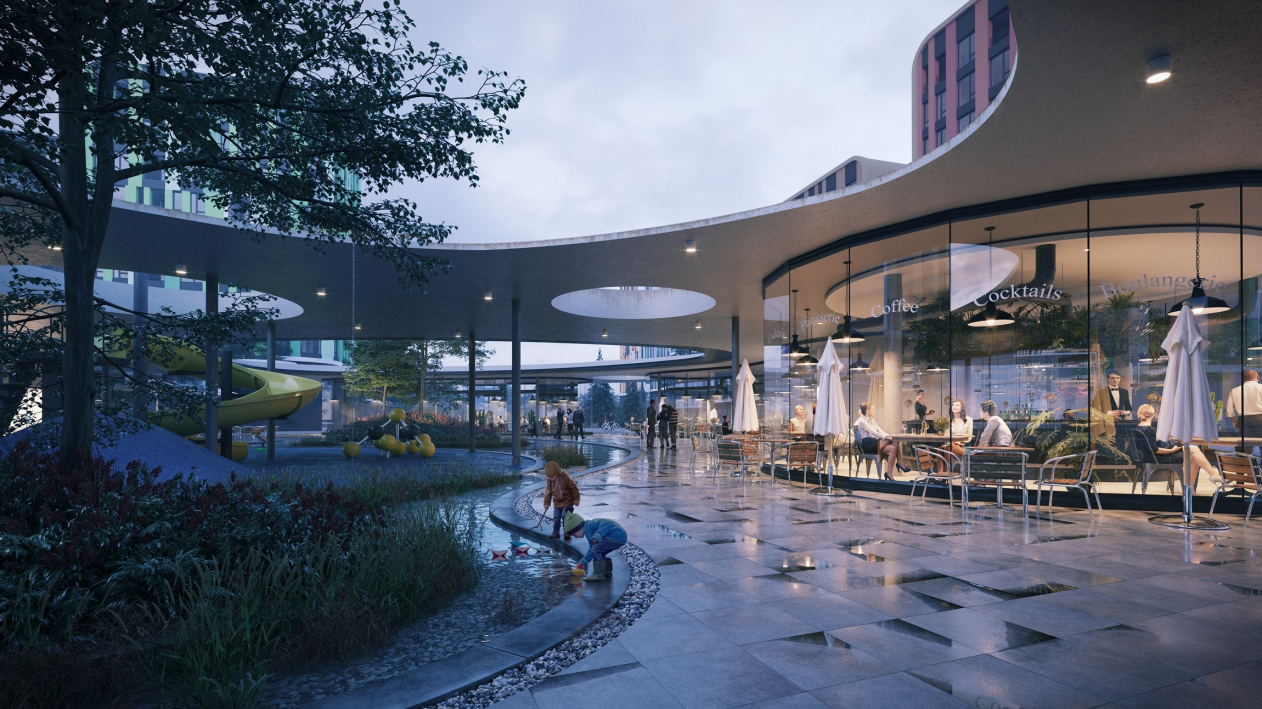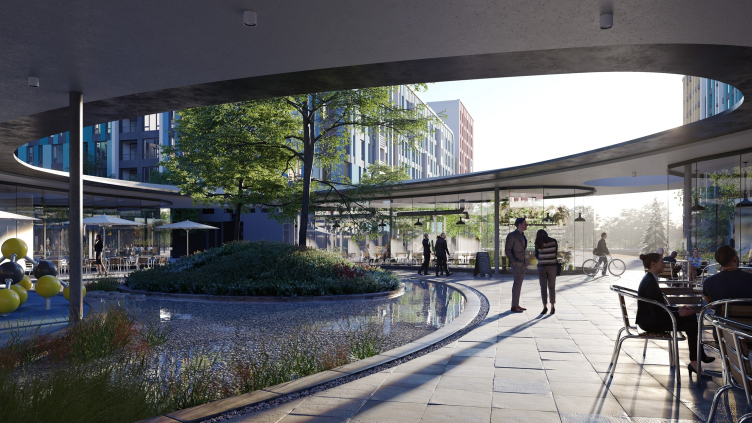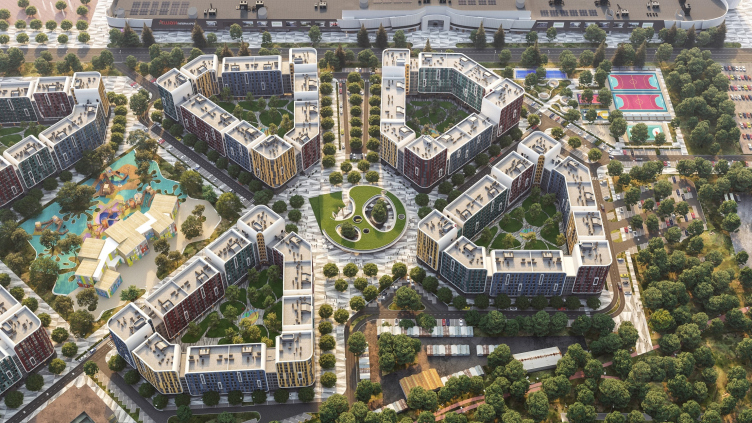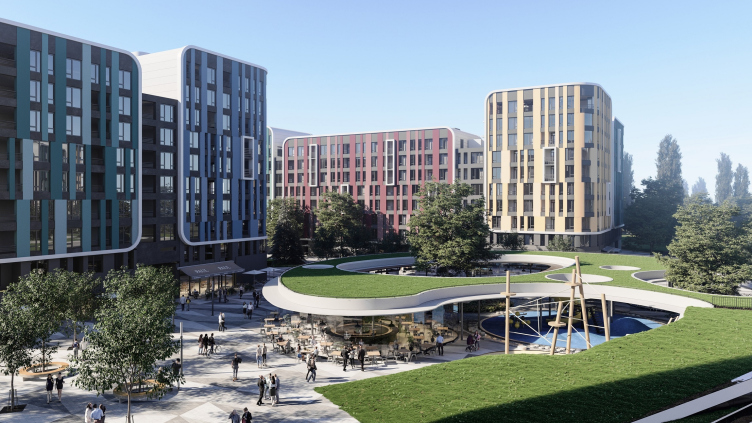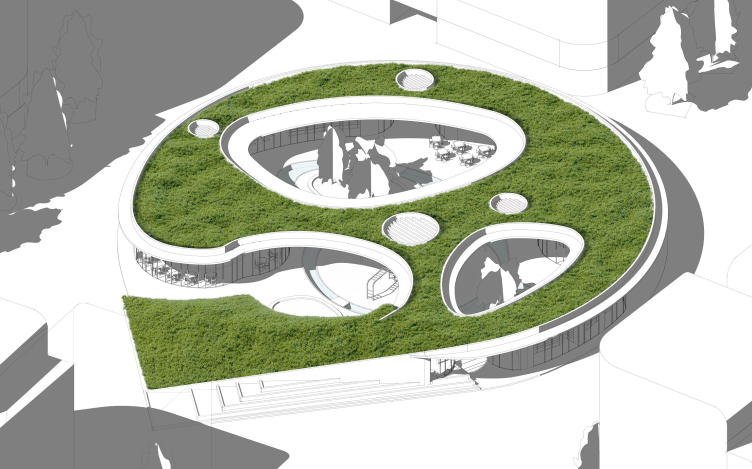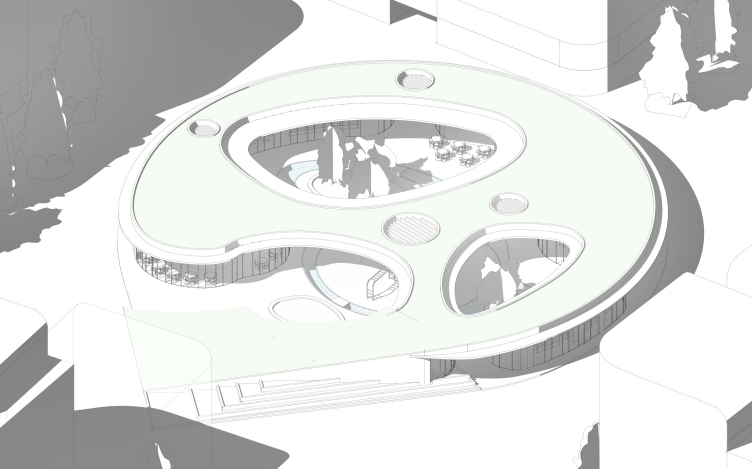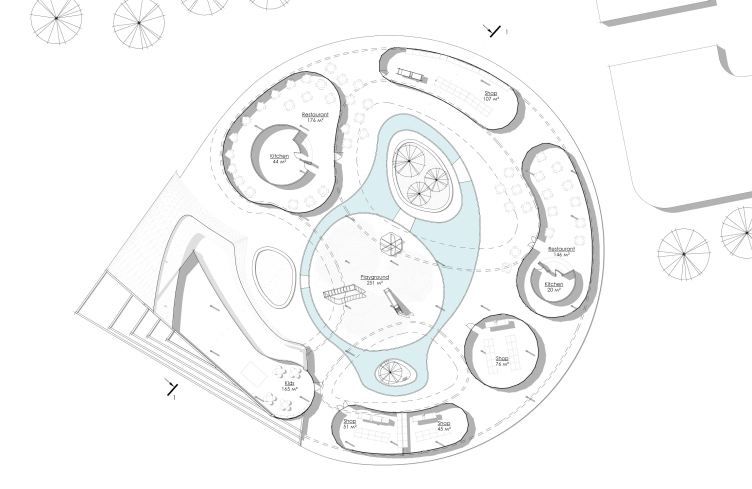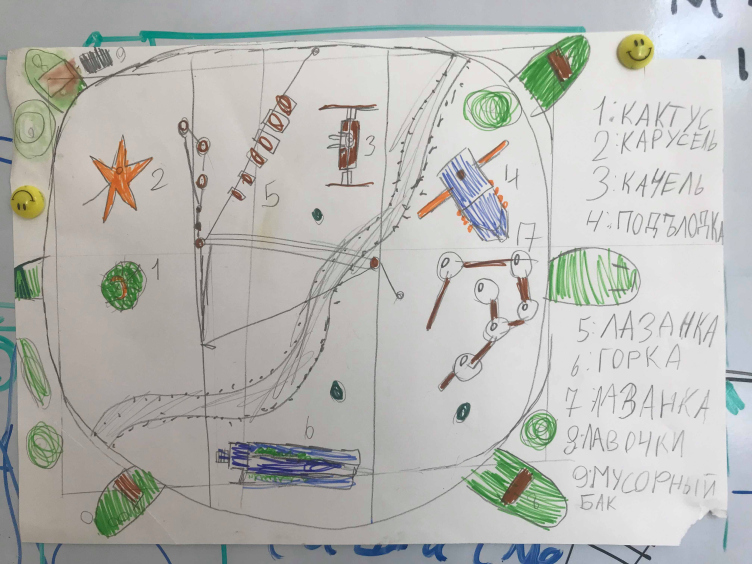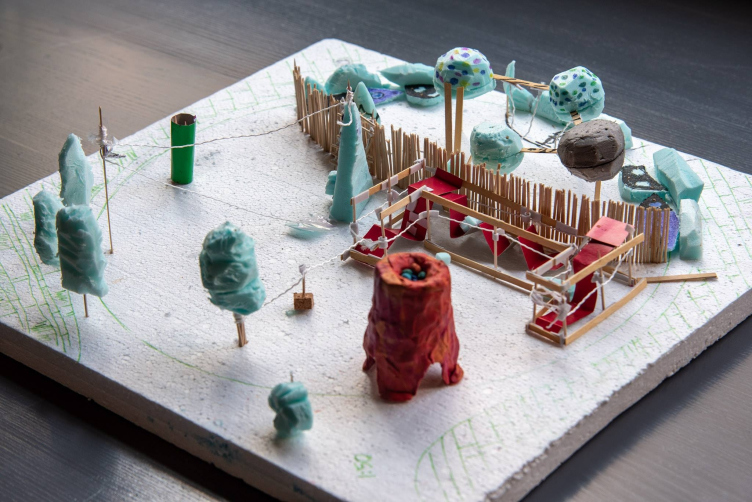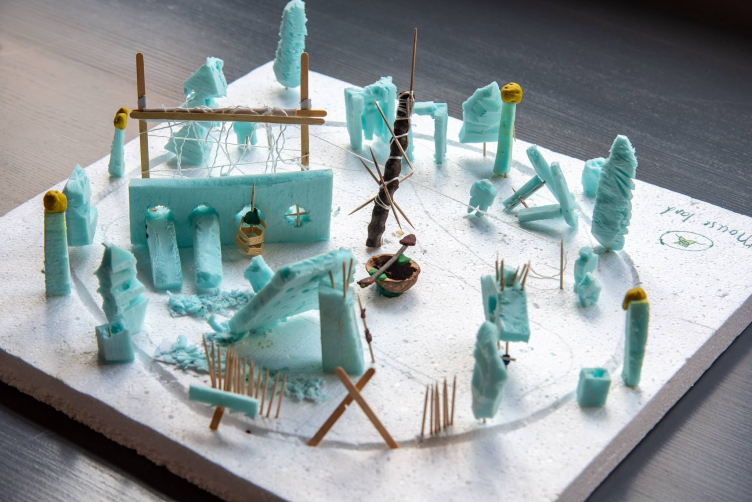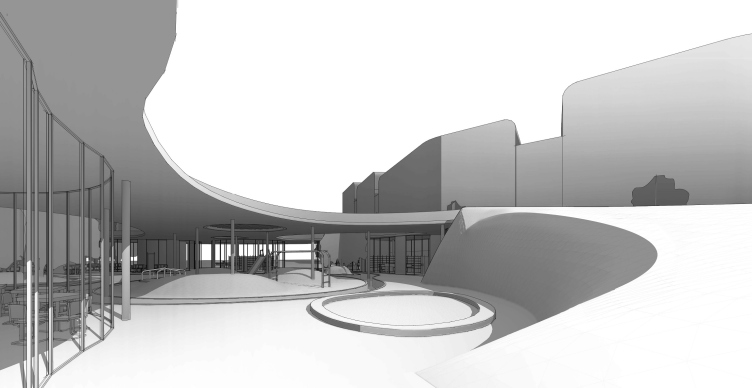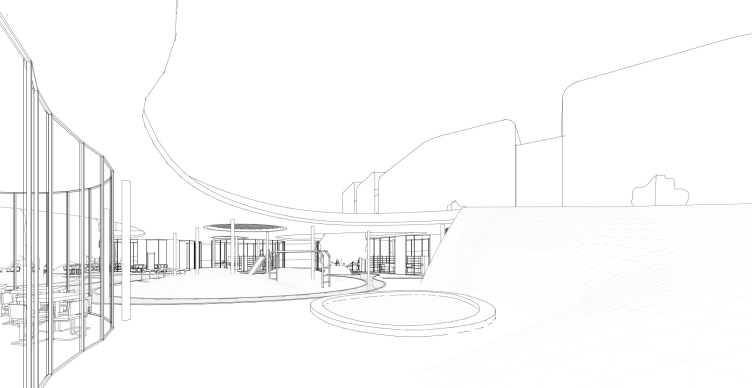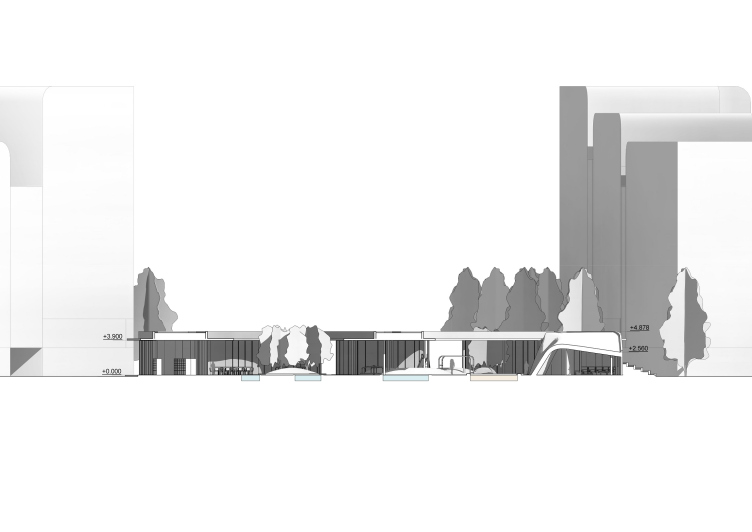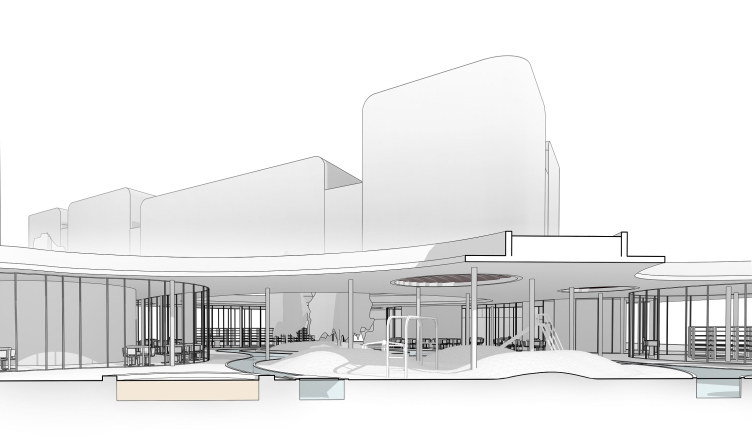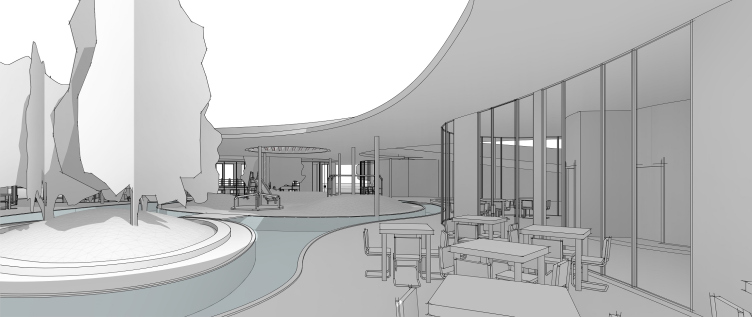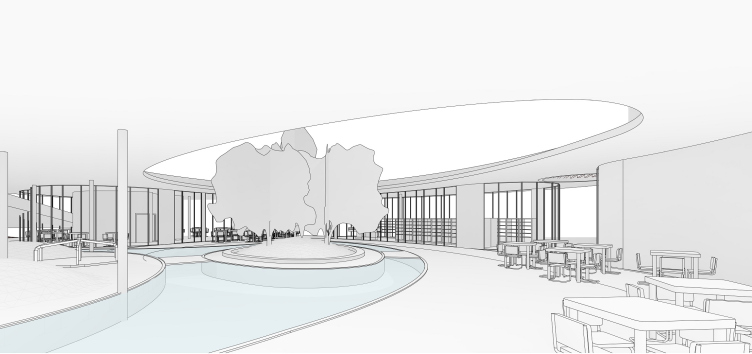The housing complex “Respublica” is ARCHIMATIKA’s and Ukraine’s largest project of this kind. At the outskirts of Kiev, not far away from the newly built “Teremki” metro station, the development company KAN is going to build what essentially appears to be a whole new town with more than 14 thousand apartments situated in buildings 7 to 9 stories high. ARCHIMATIKA is also the author of the entire infrastructure network of this housing complex – from landscaping and social projects to the shopping center that bears the same name of “Respublica” – a huge mall that has enough room for a Ferris wheel and a roller coaster. The project pays special attention to the public zones.
The community center im "Respublica" residential complex © Archimatika
The community center im "Respublica" residential complex © Archimatika
The entire complex is subjugated to the thought-out hierarchy of spaces. The closed yards of the urban blocks are only accessible to the residents. On the outside, between the blocks, there are bicycle tracks that lead to the squares where the public life will be concentrated: these can be sports fields, playgrounds, kindergartens, places for recreation with elements of landscape design, or, as was the case with the first stage of construction, a community center.
The community center im "Respublica" residential complex © Archimatika
The community center in "Respublica" residential complex © Archimatika
For placing the community center, the architects had at their disposal a square 100 by 100 meters amidst the first four urban blocks of the complex. The author of the project, Nikolai Morozov, says that the architects wanted to make the communication between the residents of the block as comfortable and as interesting as possible. Therefore, an idea was born to join the heated premises with open-air segments in order to ultimately get an all-season “communicator”. At the same time, it was important for the architects to make sure that the community center does not look like a shopping mall: the building was to be unmistakably identified as an element of territory landscaping.
The community center in "Respublica" residential complex © Archimatika
The main idea looks as follows: in the center, there is a decorative landscape part and a playground, around which “islands” of restaurants and shops are situated. These are united by a green roof that is perceived as an awning when viewed from the inside. Thanks to the openings in the roof and the skylights, there is plenty of ambient light in the shops and cafés. The free passages under the roof continue the routes of the pedestrian trails. The overall area of the center is 1670 square meters.
Ultimately, the architects got a model (according to Grigory Revzin) area, where one “exchanges, with people that he does not know, not only goods and money, but also social attention, news, and their mood”.
The community center in "Respublica" residential complex © Archimatika
The community center in "Respublica" residential complex © Archimatika
The community center in "Respublica" residential complex © Archimatika
The scenario goes like this: the adults sit around and communicate with one another, while the kids at the same time are also busy, also communicating, and the adults are able to see them all the time, feeling comfortable and secure. This is one of the reasons why the architects opted out of making the roof 100% usable. If a child, driven by curiosity and an urge to explore new heights, goes to the roof, however safe, you cannot enjoy your coffee as comfortably.
The playground is a whole new story. While working on the project, the architects wanted to come up with unconventional solutions in order to create the ultimate recreational space. In search of new interesting ideas, the architects even created a children’s focus group in order to learn firsthand from the end users what the perfect playground must be like. There was also input from the children’s studio Arch4Kids, with which ARCHIMATIKA established a great relationship.
The members of the studio, aged 10 to 15, got a real task to come up with a concept of a playground for the community center. According to Nikolai Morozov, the result topped all expectations – even professional design studios that specialize in playgrounds could not develop such a great concept. The children’s concepts were very detailed and full of fresh ideas – for, example, all of the members of the ARCHIMATIKA team, who left their work in order to see the children’s presentations, were particularly impressed by the idea of combining “Middle Ages with cheese”. The architects got not only tons of positive energy for the rest of the workday, but also a lot of insights for their future work. One of the children’s concepts was such a huge success with the architects that they are planning to offer this concept to the client at the next stages of project development.
The concept developed by the students of Arch4Kids Studio for the community center in "Respublica" residential complex © Arch4Kids. Photo courtesy by Archimatika
The concept developed by the students of Arch4Kids Studio for the community center in "Respublica" residential complex © Arch4Kids. Photo courtesy by Archimatika
The concept developed by the students of Arch4Kids Studio for the community center in "Respublica" residential complex © Arch4Kids. Photo courtesy by Archimatika
The concept developed by the students of Arch4Kids Studio for the community center in "Respublica" residential complex © Arch4Kids. Photo courtesy by Archimatika
Exploring the childhood theme, one cannot but note the likeness of the community center with the famous “oval” kindergarten in Tokyo, built upon the project by Takahara Tezuka. The same open-air space in the middle and trees growing through the roof, the only difference being that in Tokyo there are classrooms and game rooms instead of shops and cafés. But then again, the architects stress that they were inspired by quite different architectural projects.
The gently sloping part of the roof, which looks like a hill, will turn into a sleigh slide in the wintertime, the rest of the roof being closed. It is specifically this green roof that makes one perceive the community center as a landscaping element; in addition the center makes a great sight when viewed from the windows of the surrounding houses. The roof was nominated at the Ukrainian Urban Awards 2018 in the category “Innovations in construction / green roof” and got positive feedback from many of the members of the judging panel.
The community center in "Respublica" residential complex © Archimatika
The community center in "Respublica" residential complex © Archimatika
Many of the features of the concept of “Respublica” housing complex are based on the principles of modern urbanism: priority is given to pedestrians, the cars are left “outside the perimeter”, there are areas, each of which has a type of activity of its own, and there are scenarios for people spending their time in winter, in summer, and even in the rain. One can easily imagine these streets being filled with people because they invite everyone to leave their homes, offering everyone something to do to his liking, turning the suburban blocks into a charming little town.
The community center in "Respublica" residential complex © Archimatika
The community center in "Respublica" residential complex © Archimatika
The community center in "Respublica" residential complex © Archimatika
The community center in "Respublica" residential complex © Archimatika

